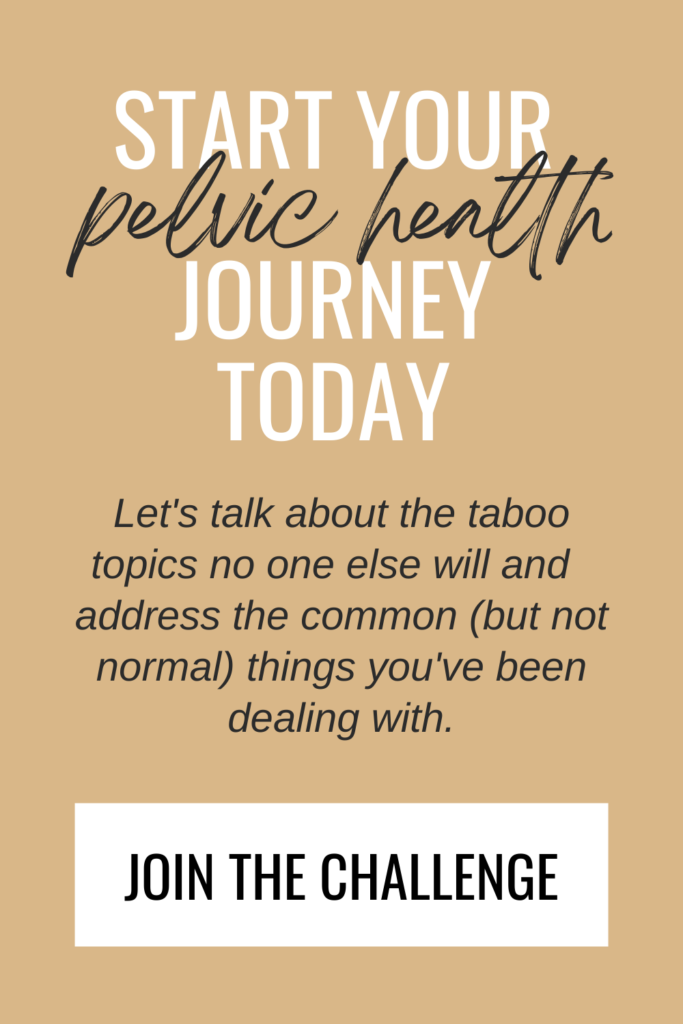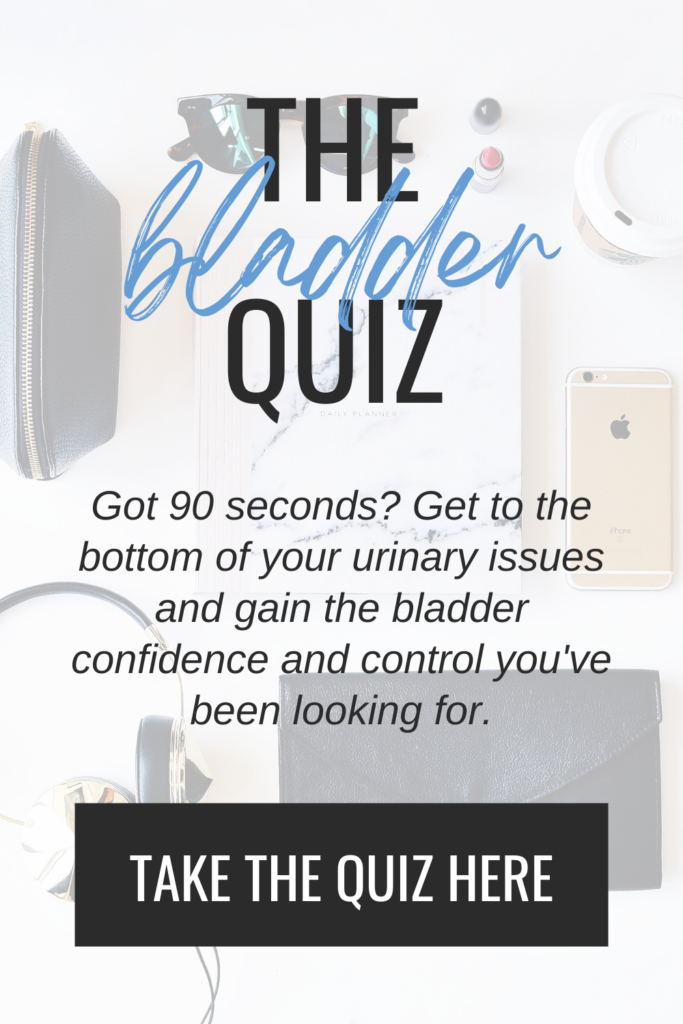I married a man who ~loves~ coffee, and I’ve willingly become quite the coffee snob connoisseur myself. Now…I’m not talking about the dirt water that is Starbucks (more on that later), but rather fresh ground in the morning, poured from our “it costs how much!?” espresso machine, frothed raw milk (and a few other additions) goodness that I’ve found most coffee shops can’t come close to beating.
If you’re a coffee drinker too, it’s likely you have your go-to morning recipe (keep scrolling for my *chef’s kiss* concoction) or typical order at your favorite stop on the way to work or school drop-off.
And if you do in fact find yourself with a cup o’ joe in your hand more mornings than not, it’s also possible you miiiiiiiight experience urinary urgency (the “gotta go now” feeling), urinary frequency (peeing more than once every two to three hours), or even incontinence (leaking urine) after enjoying your daily fix.
While this oh-so-tasty, superpower-filled gift from God can rival the longest of nights, earliest of mornings, or a combo of the two if your 18-month-old is going through a sleep regression (hi…it’s me!), coffee’s also a known bladder irritant that can leave even the most serious of java sippers second-guessing their decisions.
As a pelvic rehab therapist, I see this all the time. Shoot, even I have to bust out the pee-pee dance between my cup and commute on occasion. But if bladder issues after the brew has become your regular, or if it’s worsening to the point you’re wondering if coffee is worth it…*gasp*…then you’ve gotta keep reading to see how you (and your bladder) can still enjoy your daily caffeine jolt.
FIRST…WHY COFFEE IRRITATES YOUR BLADDER
Blessed be the person who invented coffee (they’re regular on my gratitude list, if I’m being honest), but it really is a double whammy on the bladder. Not only is coffee acidic with a pH around 5, but it also contains caffeine, both of which can irritate the bladder lining. Here’s how—
As the bladder fills with urine, the inner lining of the bladder wall expands to accommodate the increased liquid volume. The bladder is a muscle that stretches as it fills, contracts when it empties, and both caffeine and acidic foods/beverages can cause muscle spasms which trigger urinary urgency, frequency, and even leakage.
If you experience bladder irritation but aren’t quite sure if coffee is the culprit, completing a 3-day bladder tracker (no urine measuring required!) can be helpful. Grab this easy-to-follow downloadable (and FREE) bladder tracker, complete with instructions for filling it out and guidance on how to interpret your results. If at the end you realize coffee is in fact the issue, then you may want to rethink your coffee consumption.
But fear not…
There are multiple steps to take and strategies to try before giving up this liquid energy for good. With a few adjustments and a bit of mindfulness, it’s 10000000% possible to reduce the negative side effects of coffee and enjoy your cup without regret or repeated bathroom runs.
DRINK BETTER COFFEE
Like most things in life, all coffee is not created equal…literally. Depending on how your coffee beans are harvested, roasted, ground, and stored, they can have mold, pesticides, herbicides, fungicides and other harmful chemicals that contribute to bladder irritation. Unfortunately, many of the mass-produced coffees that you find at the grocery store or big name cafes (ie Folgers, Maxwell House, Dunkin Donuts, Starbucks, and Seattle’s Best to name a few) fall into this category and may be the reason for your issues.
When choosing coffee that’s “better” for the bladder, I look for a few things—
1. Buy whole bean coffee and grind it yourself. Grinding down the bean speeds up mold development, and most of the pre-ground coffees in k-cups, tins, or bags have been ground months (and months and months) before you purchase them. And more mold = more bladder irritation. I’ve also found that fresh ground coffee just magically tastes better, and being able to customize your grind size based on your coffee-brewin’ method makes all the difference. (This is the grinder the Davis fam uses. Like I said…we fancy over here).
2. Find coffee that’s fresh and locally roasted if possible. As a PNW girl, I’m privy to some of the best coffee EV-ER right in my backyard. Buying coffee that’s roasted in smaller batches and within the last few weeks helps ensure it’s fresher and contains less of the bad stuff. Always look for a roast date on the coffee’s packaging. If it doesn’t have one, I wouldn’t buy it.
PS- Here are a few of my Washington favorites that you too can get delivered to your front door with just a few clicks!
3. Use coffee that’s organic and third party tested. I’ve seen massive improvement in how my bladder handles coffee by changing to the local and fresh roasted options above, but if you want or need something even cleaner, there are also organic coffees that claim strict testing for mold and harmful chemicals. I don’t personally drink these, but have heard good things about the following brands.
Fresh, local, or organic coffee can be a bit more expensive, and finding the brand(s) that work for you can take some trial and error. But I think it’s worth it to put in the effort and pay a few extra bucks for coffee you and your bladder can truly enjoy.
CHANGE UP YOUR COFFEE STYLE + TYPE
By now you know that coffee is a bladder irritant due to it’s acidity and caffeine content. While you can’t change the acidity, you ~can~ control the amount of caffeine you consume, and therefore reduce the negative effects on the bladder. Going decaf is an obvious option, but if you still want those energy boostin’ benefits that coffee boasts, there’s a few other things you can try.
1. Change your brewing method. One shot of espresso contains about 63 mg of caffeine, whereas 8 oz of drip coffee has around 95 mg. Try adding hot water or milk to your espresso shot to increase the volume of coffee you get to enjoy without upping the caffeine content.
2. Use darker roasts. The darker the roast, the less caffeine. Dark roasts are left in the heat longer or are heated to a higher temperature, both of which cause the beans to lose more moisture, more density, and more caffeine.
3. Be mindful of your bean type. There are four types of coffee beans – Arabica, Robusta, Excelsa, and Liberica – with Arabica and Robusta being the two most common. Arabica beans have almost half the amount of caffeine as Robusta and are an easy way to significantly reduce your caffeine consumption without too much sacrifice.
Channel your inner Sherlock Holmes and become an investigator with the above! This is the perfect excuse to dabble in different coffee types, roasts, and styles. If and when you discover an option that doesn’t make you run to the bathroom ten minutes later…you’ve got a winner!
IT MAY NOT BE YOUR COFFEE AT ALL…
Hellooooooo from Mrs. “Would You Like Some Coffee With Your Creamer?” herself. While those flavored syrups and rich creamers can be oh-so-tasty, food dye, corn syrup, and artificial sweeteners are also common bladder irritants and often found in typical coffee extras. So if you regularly order or make yourself a cup filled with one or more of the above, you’re baaaaaasically consuming a bomb for your bladder.
I recommend doing a little testing with that downloadable bladder tracker – try drinking plain coffee or adding something a little less “artificial” for about a week. (Great creamer swaps would be cow or goat milk, oat milk, nut milk, and even half-and-half. Yummy sweetener alternatives include coconut sugar, honey, or maple syrup.) If you notice your urinary leakage, urgency, and/or frequency decrease, then it’s likely those coffee additions were the problem.
The good news…you can still enjoy your coffee (yay!). But if you want those bladder issues to improve, you might want to change what you use to spice up your morning cup. I’ve created the most amazing at-home recipe that’s so tasty I prefer it over any coffee shop concoction every time. This is adapted from the Nourished Soul Recipes E-Cookbook and is a ~must~ try IMO—
INGREDIENTS:
- 2 shots freshly ground and poured espresso
- ½ tsp coconut sugar
- ¼ tsp vanilla
- pinch of salt
- 1 raw egg yolk (trust me here…it’s sooooo good, but can be omitted if it’s not your thing)
- 1 cup raw milk (or milk of choice)
HOW TO:
1. Place raw egg yolk (from organic, pasture raised chickens…quality matters here) in the bottom of your cup.
2. Mix vanilla, coconut sugar, and salt with egg yolk until smooth
3. Pour espresso over egg yolk and mix again
4. Froth milk and pour over espresso
5. Enjoy!
Not only has overhauling my morning coffee helped my bladder, but it’s also significantly changed how this daily drink effects my energy, mood, and hormone function. Comin’ from a girl who does not like her coffee black, I’m here to tell you there’s a way to make your coffee delicious without bladder irritants…it just takes a little imagination and a whole lotta experimenting.
RELATED POST: 7 Holistic Menstrual Cycle Hacks to Help You Thrive During Your Period
CONSUME LESS COFFEE
*Gasp!*
Dare it say it, but my two to three (to five) cups a day people may just be consuming too much caffeine for their body to handle. While coffee does have some noted health benefits including increased energy and lower risk of diabetes, liver cancer, and Parkinson’s disease, too much caffeine can also cause insomnia, anxiety, digestive issues, muscle breakdown, high blood pressure, high heart rate, fatigue…and bladder issues.
How much is too much is different for every person, but most research shows the average person is “safe” drinking about 400 mg of coffee per day.
When it comes to your bladder, this can take a bit of trial and error (have you downloaded that bladder tracker yet???) to find how much you can personally tolerate. If you’re a three-cup-a-day kinda gal, go down to two and see what happens…then one if you need to. Simply decreasing the amount of coffee you’re drinking can really be all you need to notice improvement in those annoying bladder issues.
DRINK WATER BEFORE + AFTER
If you’re adamant about not changing any of the above but could really use less bladder symptoms, sometimes an easy fix is drinking water before and after your cup(s) of coffee. This can help “dilute” the bladder and minimize the effects of the acidity, caffeine, and other bladder irritating additions.
For every serving of coffee you consume (8 oz of drip or one espresso shot), drinking 8 oz of water before and after can help. While it may seem counterintuitive to add more liquid to the equation, in this instance, bladder irritation is more from the concentration of fluid in the bladder, not volume. Adding water reduces the strength of what’s entering the urinary tract and creates a happier bladder environment.
STILL HAVING ISSUES?
If you try all of the above and still have bladder issues post coffee, I’m here to tell you that all is not lost. There are a few other strategies that might be your answer—
1. Work around it. If you’re willing to accept that your bladder + coffee = a few urinary issues after you (a) aren’t willing or able to attempt the practices above or (b) tried everything with no success, there are two pelvic floor techniques you can do on the bladder side of the equation to help with urinary leakage, urgency, and frequency. This free guide has easy to implement (like…start today) exercises for urinary leakage, urgency, and frequency that you can use to decrease urinary issues created by (or not created by) coffee.
2. Try a coffee substitute. Start by asking yourself why you love coffee so much. Is it the taste? Warmth? Energy? Cozy morning ritual? The time you share with your friend or significant other regularly? All of the above? If you can identity what it is about coffee that you enjoy, it can be easier to find a substitute that meets your needs and reasons for coffee. There are so many alternatives out there with the same effects but not the bladder-irritating qualities. A few popular ones are:
Coffee can be a cult, an addiction, even a way of life (potentially all of the above in the Davis household), but it doesn’t have to affect your bladder health. I’m a have your cake and eat it too kinda gal and firmly believe that you can enjoy your java without repetitively running to the restroom afterwards.
So now I’m curious…would you try one (or more) of these strategies? And if so, which one do you think would be the easiest to implement first? I’d ~love~ to hear your opinion in the comments.
Urine leakage is not normal. Urinating more than once every two to three hours is not normal. Having to rush to the bathroom is not normal…coffee or not. Common bladder issues can and should be addressed, and I hope you find the answers you’ve been looking for right here.
– Amanda
Disclaimer: The content provided here does not constitute medical advice, nor is it a substitute for personalized healthcare. If you have concerns about a medical condition, diagnosis, or treatment, you should consult with a licensed healthcare professional.
Disclosure: Some of the links above are affiliate links, meaning, at no additional cost to you, I will earn a commission if you click through and make a purchase. No pressure, but I have a feeling you’re gonna like what I’ve taken the time to put my recommendation behind.




















